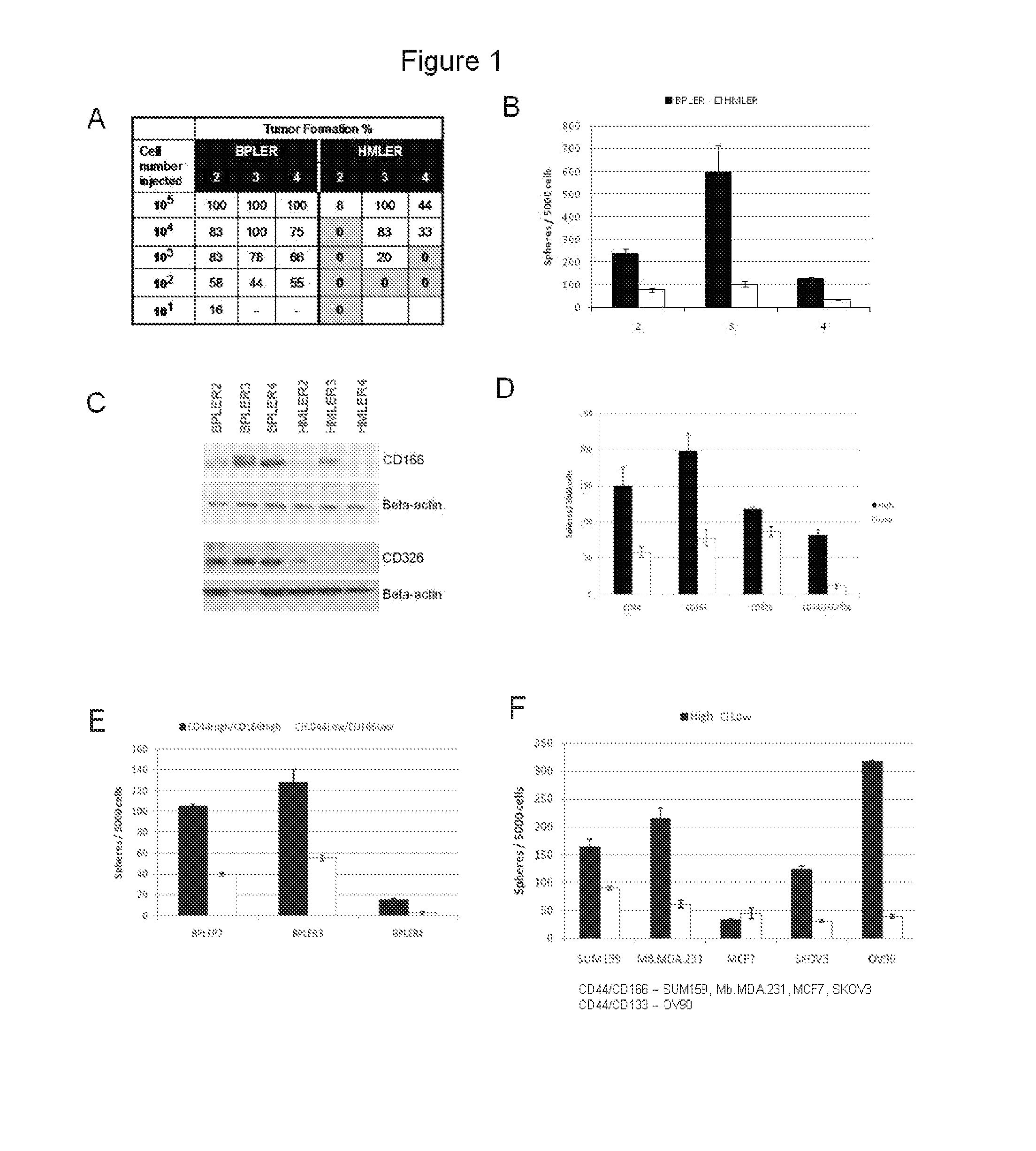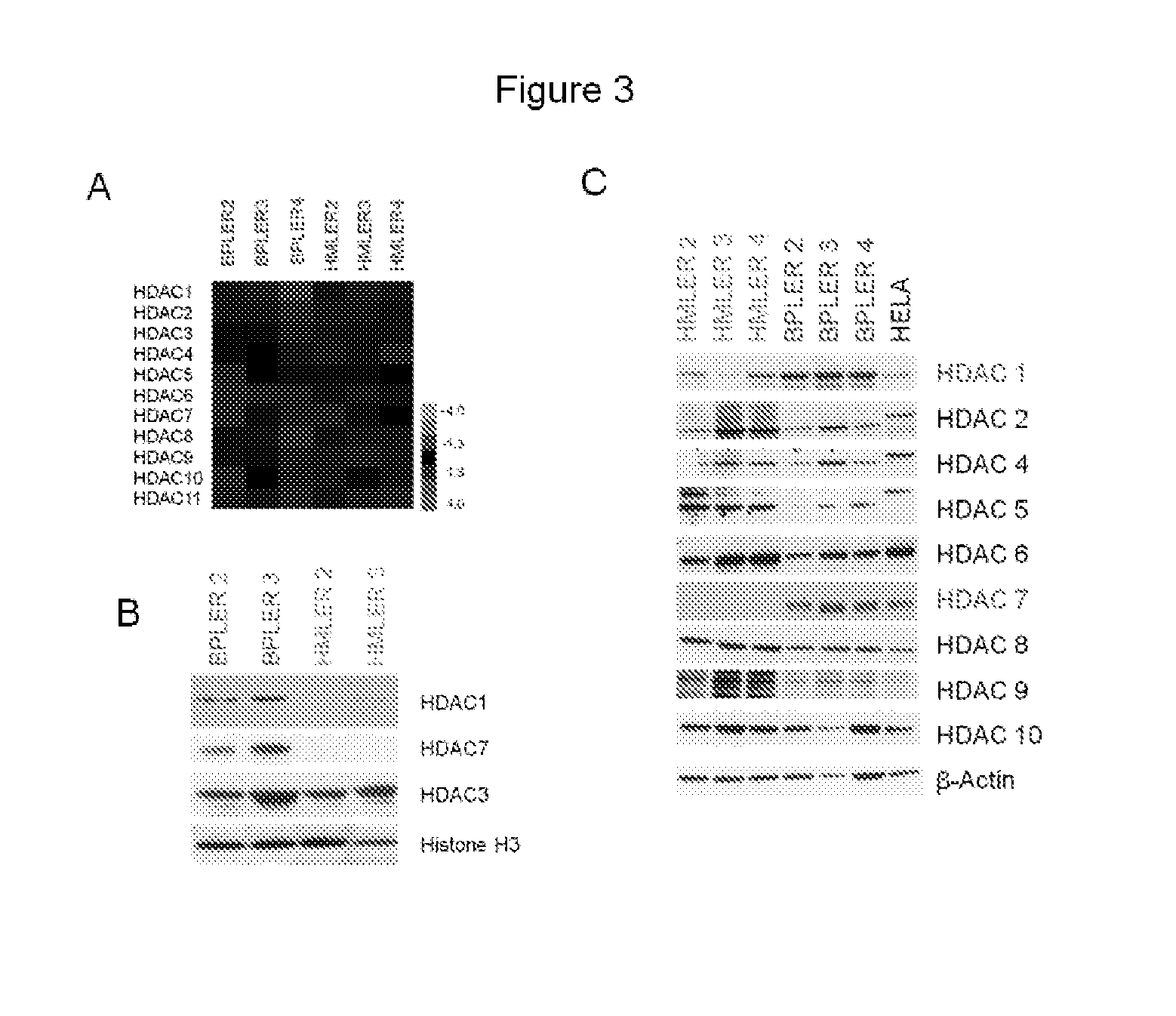Markers for and methods of targeting tumor stem cells
a tumor stem cell and marker technology, applied in the direction of tumor/cancer cells, organic chemistry, genetic material ingredients, etc., can solve the problems of unclear regulation mechanisms that control tsc gene expression and lead to malignant tumor initiation and proliferation, and achieve the effect of inhibiting or eliminating tumor stem cells
- Summary
- Abstract
- Description
- Claims
- Application Information
AI Technical Summary
Benefits of technology
Problems solved by technology
Method used
Image
Examples
example 1
Subpopulations of Isogenic Tumor Cells have Stem and Non-Stem Properties
[0220]Using a model pair of isogenic breast tumor cell lines, it was determined that subpopulations of isogenic tumor cells have stem and non-stem cell properties. To analyze differences between TSCs and non-stem tumor cells (non-STCs), two cell types BPLER and HMLER which are similar to TSCs and non-STCs, respectively were used. It was observed that the BPLER breast tumor cells formed tumors with as low as 5 unsorted cells per injection which is similar to that of Fluorescence-activated cell sorting (FACS) purified TSCs. HMLER cells, on the other than, were shown to be similar to non-STCs in that at least 104-6 unsorted cells were required for tumor formation within these cells.
[0221]The results were replicated using additional pairs of cells and it was confirmed that BPLER cells are orders-of-magnitude more capable of initiating tumors than their isogenic HMLER pair (FIG. 1A). Similarly, BPLER cells demonstrat...
example 2
HDAC Inhibitor TSA Specifically Targets Tumor Stem Cells
[0223]Above a BPLER / HMLER model pair of isogenic breast tumor cell lines that provided a well controlled setting for evaluating the differences between TSCs and non-STCs was discussed. Using these BPLER / HMLER model pairs, the functionality of TSCs as a viable target for the treatment of human tumors was further evaluated. The response of these BPLER / HMLER pairs to the HDAC inhibitor trichostatin A (TSA) was assessed and we found that the HDAC inhibitor TSA specifically targets tumor stem cells. For example, the LD50 for TSA applied to TSC-like BPLER cells was an order-of-magnitude lower than the LD50 for TSA applied to the non-STC-like HMLER cells (FIG. 2A). When treated with conventional chemotherapeutics, however, BPLER and HMLER cell types showed similar sensitivity, namely the LD50 for paclitaxel and 5-fluorouracil did not differ between BPLER and HMLER cell types (FIG. 2A). Taken together, this data suggests that the class...
example 3
Tumor Stem Cells Possess Increased Levels of HDAC1 and HDAC7 Protein
[0225]Above it was demonstrated that TSA, a non-selective HDAC inhibitor, specifically inhibited the TSC phenotype by selectively inhibiting tumorsphere formation in TSC-like BPLER cells. To elucidate a specific TSC target of TSA, expression of HDACs in BPLER and HMLER cells was evaluated. Human cells contain 18 HDACs which are organized into four distinct classes (Class I through IV). Class I HDACs include HDAC1, HDAC2, HDAC3 and HDAC8. Class II HDACs include HDAC4, HDAC5, HDAC6, HDAC7, HDAC9 and HDAC10. Class III HDACs (members of the SIRT family of proteins) are NAD+ dependent deacetylases and therefore were not evaluated further. Class IV HDACs (HDAC11) are zinc-dependent enzymes. Class IV HDACs are the target of some HDAC inhibitors currently in clinical use. HDAC inhibiting drugs inhibit different subsets of the HDAC family. Some drugs, such as TSA, are known to inhibit both Class I and Class II HDACs in human...
PUM
| Property | Measurement | Unit |
|---|---|---|
| mass | aaaaa | aaaaa |
| mass | aaaaa | aaaaa |
| mass | aaaaa | aaaaa |
Abstract
Description
Claims
Application Information
 Login to View More
Login to View More - R&D
- Intellectual Property
- Life Sciences
- Materials
- Tech Scout
- Unparalleled Data Quality
- Higher Quality Content
- 60% Fewer Hallucinations
Browse by: Latest US Patents, China's latest patents, Technical Efficacy Thesaurus, Application Domain, Technology Topic, Popular Technical Reports.
© 2025 PatSnap. All rights reserved.Legal|Privacy policy|Modern Slavery Act Transparency Statement|Sitemap|About US| Contact US: help@patsnap.com



